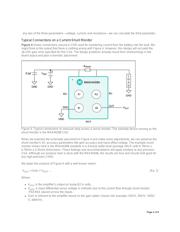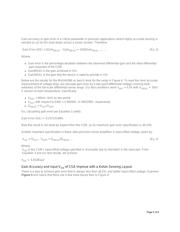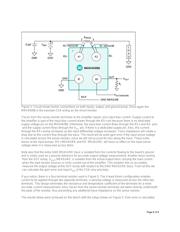下载

Keywords: CSA, CSM, DC accuracy, current sense amplifier, current shunt monitor, current-sense
amplifier, current-shunt monitor
APPLICATION NOTE 5761
LORD KELVIN’S SENSING METHOD LIVES ON
IN THE MEASUREMENT ACCURACY OF
ULTRA-PRECISION CURRENT-SHUNT
MONITORS/CURRENT-SENSE AMPLIFIERS
By: Srudeep Patil, Member of Technical Staff
Abstract: Ultra-precision, high-side current sensing is crucial in applications where the correct amount of
current entering or leaving the battery needs to be measured to a very high degree of precision. This article
discusses the care that a layout designer and design engineer need to take to measure ultra-high precision
voltage drop across a shunt resistor. These measurements are enhanced utilizing the proven Kelvin
sensing methods with a four-terminal sense resistor.
Introduction
Ultra-precision, high-side current sensing is crucial in applications where one must measure the current
entering or leaving a battery. Today many digital multimeters feature four-lead Kelvin sensing to eliminate
the series resistance of the multimeter leads and give an accurate voltage drop across a given resistor.
Similarly, a current-shunt monitor (CSM) or current-sense amplifier (CSA) measures voltage drop across a
shunt resistor based on the current flown into or out of the battery. This is how you determine the amount of
current drawn by the load from a battery in real-world applications. Systems today use low power and
require a very accurate measure of charge left in the battery. To quantify remaining charge, every
microamp drawn from the battery by the load or pumped into the battery by a charger needs to be
accounted for. Thus, ultra-precise sensing of voltage drop across the shunt is critical.
This article discusses how to measure voltage drop across a shunt resistor with very high precision. We will
show how an ultra-high-precision CSM measures voltage drop across the shunt resistor with typical
connections, and then compare this value with the CSM accuracy specification in its datasheet. Then we
examine ways to improve the measurement accuracy using that same CSM. These measurements are
enhanced utilizing the proven Kelvin sensing methods with a four-terminal sense resistor. Test results also
show that one should be careful with the board layout. Once the layout practices listed in this article are
followed, we can capitalize on Kelvin sensing and sense the microvolt level drop across the sense resistor
with ultra-high precision.
Page 1 of 8








